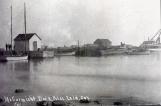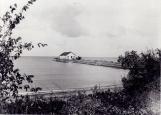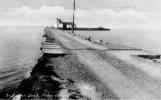1
Ironclad and Mail CarriersCirca 1925
Pelee Island, Ontario
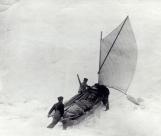 Credits:
Credits:Guy McCormick
Pelee Island Heritage Museum
2
Letter of Minnie Bird Wardroper to her father Thaddeus Smith8 November 1898
Pelee Island, Ontario
 Credits:
Credits:Voice of Vanessa Taylor
Pelee Island Heritage Museum
3
The first grape grower and early settlers to Pelee Island faced many challenges, like any early settlement. The clearing of the land, the building of houses, cultivating the soil and the planting of crops are laborious and difficult at the best of times but living on an Island brings a whole new set of unique challenges. Thaddeus Smith writes, "To come here and live was like being a pioneer in a wilderness, away from most of the advantages of civilization, and to endure many hardships and privations". The nature of a community can often be better told in what is not there, rather than what is. Being an Island the obvious absence was transportation. The prevention of early settlers from coming to the Island was on how to even get to there."There was no steamboat running to the island and no regular line of sailboats, which made it difficult for strangers to reach here. The only way heretofore by which the inhabitants could get off the island and onto it was in their own private sail or row boats, and any stranger wishing to get to the island, would have to take his chances and come by some of these boats."
The first grape grower on Pelee Island was Henry Price. It was in 1854 that he planted a small vineyard but because he did not have clear title to the land he was forced to abandon his endeavour. The Letters of Patent allowing for the proper sale and transfer of land title was granted on July 29th, 1867. The stage was set for settlement of the Island. Now the early grape growers had proper holdings of their land, the next challenge was in the acquisition of good vine stock.
The assumption is that the first vineyards on Pelee were started from grape roots obtained from south western Ohio or the neighbouring Lake Erie Islands where vineyards were already established. Subsequently, after the vineyards took hold clippings could be propagated from them. But occasionally, like in the year 1884 and 1889, there were still deliveries of vine stock from Bass Island. This could have been due to a bad crop year. Weather is the giver and taker to any crop. The extremes of hot and cold, wet or dry would bring disease, 'black rot', mildew, red blight or frost. These were persistent problems that always threatened the crop yield.
4
Island Vineyard (Kelley's Island)1910=1918
Kelley's Island, OH, United States of America
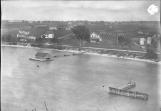 Credits:
Credits:Charles I. Frohman Collection
R.B. Hayes Presidential Center
6
After the grapes were harvested, the task at hand would be to find buyers and distribute your goods. But the marketing of the produce was one of the biggest challenges. The major hurdles were a lack of transportation, an unstable and unpredictable market, no post office or cable by which to communicate to the mainland and finally a limited labour force.In order to market their grapes and wine, Thaddeus and the Wardroper brothers had to travel to the mainland to try and find markets and buyers. Thaddeus hired J.S. Hamilton, Dunlop and Company to be his representative and through them other buyers were found.
"In 1877, a few years after the first wine was made on the Island, sales were sought in the fresh fruit market. Large quantities of grapes were shipped to fruit dealers in London, Hamilton and Toronto. In addition, in November of the same year, Smith, Williams and Company shipped on the steamer Lake Breeze 250 gallons of their native wine to a number of smaller customers. In the spring of 1878 Thaddeus Smith's remaining stock of wine, pressed from Catawba, Isabella and other varieties of grapes, was removed to the warehouse of Hamilton, Dunlop and Company in Brantford."
At a Town Hall meeting on January 8th, 1879, a resolution was passed to address the problem of poor communication to the Island. A petition to establish a post office on the Island was sent to the Postmaster General and to Members of Parliament. The petition was granted and A.M. McCormick became the first Postmaster of Pelee Island. The Post office was established out of his store at the West Dock. The benefit of having a post office and communication to better market their wines was felt immediately. It would be in 1882 that a deal was made, most likely through J.S. Hamilton, that five casks of wine would be shipped to British Columbia. This would be the first time an Ontario wine would be transported out to the West coast.
7
First A.M. McCormick Store (on right), West DockCirca 1895
Pelee Island, Ontario
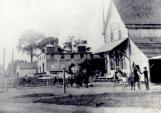 Credits:
Credits:Pelee Island Heritage Museum
8
The shipment of grapes or wine was predicated on the building and maintaining of good docks. Before the marshes were drained in 1889, there were three areas of the Island, each requiring a dock. Lemuel Brown built one of the East side of the Island, which was called Middle Island. Peregrine McCormick had one of the south end of the Island. Under the constant push and pull of the Lake, storms and ice, docks would be built and then washed away. They would be rebuilt and then washed away again. The task of the maintenance and rebuilding of the docks was like Sisyphus pushing the rock up the mountain. But the docks would push further out into the Lake to allow the life line of the Steamers to come. As the marshes were drained and more produce grown, the need and demand of the good reliable docks was paramount to getting the grapes and wine to the mainland.13
In present time, there is a love hate relationship with the transportation on and off the Island. Back then it was the same, as the boats were not reliable or not big enough or dependent on the weather and much too infrequent."The first ship operative for Pelee Island was the 'S.S. Valley City'. Captain David McCormick (William's son) purchased her and interposed her on the Pelee Island route in 1870. She was a side-wheeler and steam powered. This was the first ship that Captain Eugene McCormick (Captain David's nephew) captained".
Many boats came after this: S.S. Lake Breeze, the Erie Belle, The City of Dresden, The Queen City, the Lakeside, the Telegram and the S.S. Imperial are to name a few. It was each of these vessels that carried the tons of grapes or gallons of wine to the mainland and then onto their final destination, albeit a fruit market, the wine press or to retail. The other important function for the grape growers on the Island is that, with increased production, the steamers could not only take the grapes off the Island but it also brought the required work force to the Island for the harvesting of the grapes.
"At the end of November in 1891 it was believed that Island vineyards had furnished twenty thousand dollars worth of table grapes. In addition, 100,000 gallons of wine had been pressed. The new Wine House alone pressed 50,000 gallons in the first year, or one half the wine made on the Island. J.S. Hamilton's portion of the harvest consisted of 180 tons of 'black' grapes and 80 tons of Catawbas. At a yield of 3 tons per acre on average, the year's production represented an Island vineyard acreage of perhaps slightly more than 400 acres."
14
City of Dresden SteamshipCirca 1910
Pelee Island, Ontario
 Credits:
Credits:Institute for Great Lakes Research

